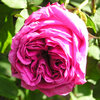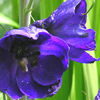20 June 2001
Luckily the last couple of days of proper warm weather have almost made
me forget the really cold and dismal weather we were enduring before that.
Monday was beautiful, and I was at last able to sit in the garden and
just 'be'. There were many bees
around too, who obviously knew how to just bee . . .
The sound of insects, and bird calls, and far-off sounds from other gardens,
all of these add to the atmosphere of the garden in summer. Once I notice
bees buzzing I feel an awareness of summer that mere vision doesn't give
me.
Alliums
The bees seem particularly fond of a plant new to the garden this year:
Nectaroscordum siculum (formerly Allium bulgaricum) - they're enjoying
its presence as much as I am, and frenetically buzzing about in its flowers.
This plant had very interesting buds on top of tall thick stems. After
looking like they were never going to open, the six I have split open
in turn over the course of two days.
The middle part of the garden is overrun with Alliums just now: 'Purple
Sensation' is fading, but Allium
christophii takes its place. Around the rather enthusiastic planting
of A. christophii (how did I end up with so many?!) there's a lovely blue
hardy geranium - given to me by a friend - which I think is Geranium
magnificum. This has grown fairly tall, so mingles with some of the
allium flowerheads.
Sweet peas
My sweet peas are pathetic this year so
far. My autumn sowing suffered from neglect, and my spring sowings were
started later than in previous years, with the result that my sweet peas
are now rather feeble, and being overshadowed by the larger plants that
have chaotically expanded after recent rains.
I'm hoping they'll do something impressive before the inevitable mildew
that strikes them later in the summer . .
Propping up the plants
I'm propping up plants all over, having neglected staking things properly, as always. I hate seeing plants visibly tied to sticks, or trussed up with string, but every year I have to wade into the flowerbeds and rescue a few, trying so hard to prop them up in a way that's not obvious, in a way they'll grow round. Maybe one year I'll manage to do this early enough in the season.
The roses are flowering profusely now, and their scent mingles with that of the orange blossom (Philadelphus coronarius `Aureus'). I spend most of my evenings at present sticking my nose into flowers, and watching that amazing evening light that, at this time of year, holds magic in it.
8 June 2001
Weather . . . and what's flowering now
'Flaming June' arrived in its usual manner - with rather wild weather,
including a few hailstones on one of its suddenly rather chilly days.
We British are obsessed with weather because it's so peculiar. This year
I was more prepared for it, having read my journal from previous years
and remembering that I always think it's hot and sunny in June in England
and in fact it very rarely is.
Many things are flowering now, despite the changeable weather. The roses
have started to flower on the archway we constructed in 1998, now looking
like it may need reinforcement under the weight of Madame
Alfred Carriere, which has opened its beautiful blooms. Some of these,
I'm pleased to say, I managed to train downwards towards nose level, so
they are more smellable.
Flowering now also is Sweet Rocket (Hesperis matronalis) - in a lovely
shade of lilac. These were bought as young plants this spring, from our
local market.
The garden has yet to reach its peak of perfection, as everything seems
a little later into bloom this year. But greenery advances, and the Golden
hop entwines itself even more gracefully this year, now an established
plant that sends out many vigorous twining stems from its bulky rootstock.
It has spread not only upwards but forwards, spilling exuberantly and
gracefully and filling every gap nearby, including the previously rather
forlorn piece of ground where we buried our cat Leaps this spring.
The Choisya
ternata and Clematis montana have been scenting the garden for the
last week or two. The montanas were resident when we moved here, and are
hanging in garlands of rampant blossom over the wall dividing us from
the street. Another montana grows in a large container by the kitchen
door into the garden, and its white blossom hangs in great drifts just
now.
Philadelphus coronarius "Aureus" - Mock orange
In the garden the golden-leaved
mock orange is flowering now - always welcome, and this year a relief
as well, as I had to relocate it last summer, and rather foolishly did
so on a very hot day, when not only was it the wrong time of year to move
it, but also the wrong kind of weather. I knew all this, but decided to
take action anyway. Its leaves had begun to show signs of scorching in
the hot sun in its position in front of a south-facing wall, and because
of the way my garden becomes like a jungle later in the summer, I knew
I had to move it while I could find space to negotiate my way through
the flowerbeds.
It looked a little sad for a while after its move, but I made a point
of continuing to water it copiously throughout the rest of the the summer.
Luckily it didn't sulk unflowering like other things I have had to move.
This year it is carrying more flowers than it ever did, now in a part-shaded
position that gets sun earlier in the day.
Nesting birds
Behind the Clematis montana blossom over the kitchen door a blackbird
has built a nest. I think this is the blackbird that is a frequent
visitor to our cat's food bowl in the kitchen . . . possibly she has
decided to settle as near as possible to good feeding facilities. Her
nest is only half a metre or so above the door, so I can see her in the
nest.
Further down the garden another blackbird's nest has several chicks, and
I guessed they were soon to emerge. At dusk today I noticed movement in
the ivy and clematis against the wall a metre or two from where this nest
is located, and discovered a young blackbird clinging to a clematis stem,
just emerged from the nest. One of the parents could be heard in a nearby
tree, and the young bird occasionally called back, no doubt hoping for
food.
Ten minutes later it had tucked its head to its side and begun to roost
for the night, looking so vulnerable and so visible where it had chosen
to rest. Rounded body with no tail feathers at all yet. But luckily a
metre or two off the ground. Probably safe from cats (and I hope also
safe from sparrowhawks).
I thought about taking a picture for this website, but would have had
to use the flash, and didn't want to startle it. Decided that coming out
of the nest into the big bad world (and currently rather chilly climate)
of my garden in Yorkshire, and then seeing my big face looming was probably
enough of a shock for the poor thing already.
Annuals and summer bedding plants
In the first couple of years I grew a lot of annuals from seed myself,
but don't really have the facilities, and don't always have the time.
I now concentrate on growing selected annuals that I like particularly
and can't seem to find in the shops. I always grow Rudbeckia 'Marmalade',
which I particularly like to see flowering in the garden in late summer.
I also love heliotrope,
but found growing it from seed without a greenhouse meant waiting for
an impractical length of time for good-sized plants. Luckily a local nursery
has included heliotrope in its range of annuals, so I buy young plants
from there each spring.
Another more recent favourite is the hardy annual Nasturtium 'Empress
of India', which is easy to grow from seed sown direct in the ground.
Last year's display was fantastic - a rather late sowing designed to fill
a very obvious gap - and it was a lucky choice. The plants didn't just
fill the gap, they cascaded beautifully over the edge of the raised bed
they were in, and flowered for ages.
No carpet of colour out there yet, but so much green, filling the gaps of winter and spring. Hardy geraniums beginning to flower, in shades of blue best seen at dusk, as the blackbirds call from here and from nearby gardens, and the scent from the mock orange comes to me on the air, and the newly fledged blackbird waits silently, and wraps its toes tightly around the clematis stem.
Back to June highlights and diaries


